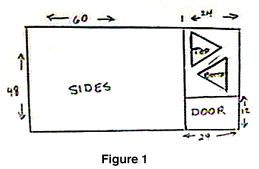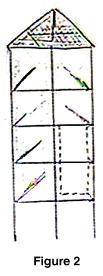
1. Unford tomato cage in upright position (extended wire legs on bottom) and fasten sides together with attached hooks. Crimp hooks closed with pliers.
2. Wrap screen around cage. The wrapped fabric should not be overly tight. Allow for a 2 inch overlap and cut. Trim top and bottom to a 2 inch overhang.
3. Center the overlap over one of the vertical wires of the cage. Using coated wire (or monofilament line and needle), “sew” the overlap closed by going through the screening and around the vertical wire. Do not sew around the top and bottom edges yet.
4. Cut a 24 inch x 48 inch piece of screening to make the top, bottom and door for your cage (see figure 1). Cut two triangular pieces of window screening to fit the top and bottom of the cage. Allow for a 2 inch overhang on all sides. Cut a door 24 inches x 12 inches.

6. Cut a vertical rectangular flap in two adjacent squares on the cage wire frame. When cutting the flap, cut about 1 inch inside the frame wires (see figure 2). The loose end of the flap should be at the bottom of the cage.

8. Place newspaper in bottom of cage for easy clean up.
9. When placed outdoors, press leg extensions into the ground until the bottom of the cage rests flat. If used indoors the legs should be bent outward until flat.